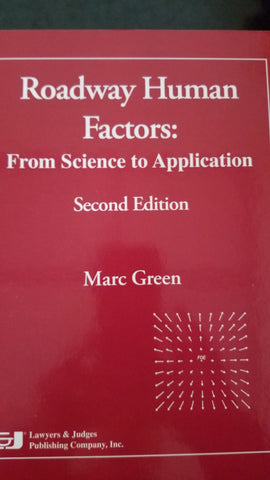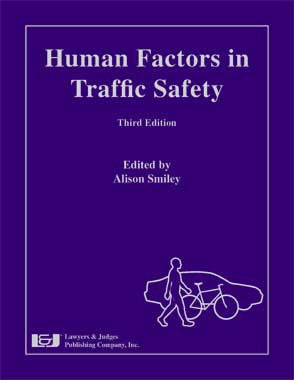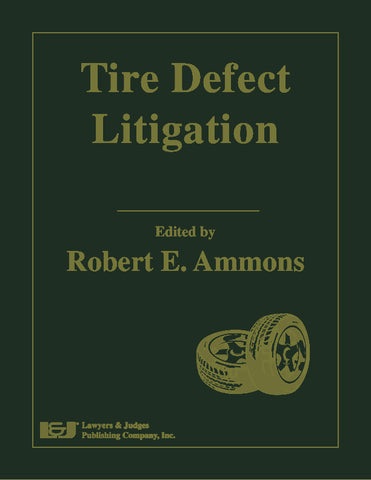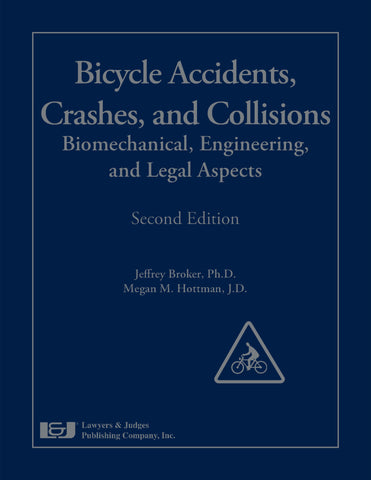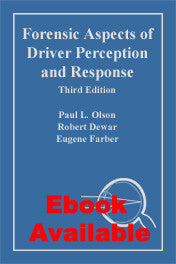
Forensic Aspects of Driver Perception and Response, Third Edition
- Author: Paul L. Olson, Robert Dewar, Eugene Farber
- ISBN 10: 1-933264-78-0
- ISBN 13: 978-1-933264-78-3
- Copyright Date Ed: January 1, 2010
- Pages: 494 pages
- Binding Information: Hardcover
- Size: 6 ✕ 9 Inches (US)
- Product Code: #5228
This brand new third edition of Forensic Aspects of Driver Perception and Response contains invaluable new information you need to know about driver perception and response and related human factors and design issues.
This text contains the most current information available in the area of driver perception and perception-response time. Existing chapters have been expanded, providing in-depth coverage of areas such as light reflecting surfaces, visibility enhancing materials, driver age, gender and experience, fatigue, speed perception and vehicle size, vehicle lighting and marking, glare, and more. Many of these were only briefly mentioned or not included in the earlier editions. Additionally, new chapters have been added to present completely new material on many related driver perception and response issues including roadway design and the driver, work zones, railroad grade crossings, roadway signage, weather and driving and driver distraction.
If you work with driver perception and response cases in any capacity, this book is an invaluable addition to your reference library.
Topics Include:
- Human factors in accident reconstruction,
- human variability and expectancy,
- Measurement of visual performance,
- Conspicuity,
- Judgments of speed and distance,
- Lighting sources other than vehicle headlamps,
- Driver distraction
Table of Contents
Chapter 1: Introduction
1.1 Purpose and Scope
1.2 Human Factors in Accident Reconstruction
A. Introduction
B. History
C. Human Factors in Product Evaluation and Development
D. Applicability of Human Factors to Accident Reconstruction
1.3 Human Variability
A. The Problem
B. Descriptive Statistics
C. Correlation
D. Inferential Statistics
E. The Concept of Threshold
1.4 Expectancy
A. What It Is
B. Driver Expectancy
Chapter 2: Light and Its Measurement
2.1 Introduction
2.2 The Nature of Light
2.3 Definitions
A. Light-Reflecting Surfaces
1. Diffuse reflectors
2. Specular reflectors
3. Retroreflectors
B. Miscellaneous Visibility-Enhancing Materials
1. Fluorescent materials
2. Luminous materials
2.4 Photometry
A. Luminous Intensity and Illuminance
B. Luminance
C. Means of Measurement
Chapter 3: Vision, Audition, Vibration and The Processing of Information
3.1 Introduction
3.2 Vision
A. Measurement of Visual Performance
1. Acuity
2. Contrast Sensitivity Function
3. Other Measures of Visual Performance
4. Relationship Between Vision Tests and Driving Performance
B. Structure and Performance of the Eye
1. Structure
2. The Functioning of the Visual System at Different Levels of Illumination
3. Implications for Vision Due to the Structure of the Eye
C. Glare
1. Disability Glare
2. Discomfort Glare
D. The Useful Field of View
E. The Twilight Period
3.3 Auditory Issues
A. Problems with sound
B. Noise
3.4 Vibration
3.5 Information Processing
3.6 Memory Questions
Chapter 4: Driver Eye Movements and Visual Attention
4.1 Introduction
A. Terminology
B. Methodology
4.2 Driver Eye Movements
4.3 Driver Experience
4.4 Negotiating Curves
4.5 Effects of Drugs and Alcohol
4.6 Effects of Fatigue
4.7 Vehicle Characteristics
4.8 Age and Sex
4.9 Interior Glances
4.10 Effect of In-Vehicle Devices
4.11 Use of Mirrors
A. Duration of Routine Mirror Glances
B. Duration Of Mirror Glances In Connection With Merges And Lane Changes
C. Mirror and Direct Rearward Glances when Changing Lanes and Merging
D. The Timing of Rearward Glances with Respect to the Gore
4.12 The Effect of Secondary Glances on Accident Avoidance
Chapter 5: Conspicuity
5.1 Introduction
5.2 Motorcycle and Bicycle Conspicuity
5.3 The Conspicuity of Emergency Vehicles
5.4 Truck Conspicuity
5.5 Pedestrian and Pavement Delineation Conspicuity
Chapter 6: Driver Perception
6.1 Introduction
6.2 Perception as Contrasted to Sensation
A. Definition
B. The Nature of Perception
6.3 Illusions
6.4 Applications
6.5 Difficulties in Perception While Driving
A. Problems with the Roadway
B. Violations of Expectancy
C. Judging Distance to Lights
6.6 The Intruding Vehicle
6.7 Positive Guidance
6.8 Eyewitness Testimony
Chapter 7: Judgments of Speed and Distance
7.1 Introduction
7.2 Perception of Distance
7.3 Perception of Speed
7.4 Threshold for Closing Speed
7.5 Speed Perception and Vehicle Size
Chapter 8: The Driver’s Field of View
8.1 Introduction
8.2 What a Driver Must See
8.3 Field-of-View Targets
8.4 Driver Eye Locations
8.5 Binocular and Ambinocular Vision
8.6 Obstruction of the Forward Field of View
8.7 A-Pillar Obstruction of Intersecting Vehicles
8.8 A-pillar Obstruction of Pedestrians and Bicyclists
8.9 Measuring Pillar Obstructions in the Field
A. Measuring the Ambinocular A-pillar Obstruction of a Pedestrian
B. Measuring the Ambinocular A-pillar Obstruction of an Intersecting Vehicle
8.10 Obstructions to the Side and Rear
A. A Note on Convex Mirrors ("Objects in Mirror Are Closer than They Appear")
B. Mirrors and Overtaking Vehicles
C. Pillar Obstructions to the Side and Rear Direct Fields-of-View
8.11 The Field of view from Large Trucks
8.12 Measuring the Field of View in Large Trucks
Chapter 9: The Visibility Provided by Vehicle Lighting Systems
9.1 Introduction
9.2 The Importance of Target Contrast
A. Definition
B. Calculating Contrast
9.3 The Reflectivity of Objects in the Real World
9.4 Driver Vision at Night
A. Vehicle Lighting Systems
1. Technology Used in Automotive Lighting
2. Enhanced Vision Systems
3. Characteristics of U.S. Headlamps
4. The intensity-visibility distance relationship
5. Implications
B. The Visibility Provided by Automotive Headlamps
9.5 Nighttime Driving Speeds
9.6 When Drivers "Overdrive" Their Headlamps
Chapter 10: Factors That Affect Driver Visibility Under Nighttime Driving Conditions
10.1 Introduction
10.2 PCDETECT
10.3 The Distance-Squared Law and Visibility Level
10.4 Comparisons
A. Target B. Target Location
C. Target Size
D. Driver Age
E. Contrast Sensitivity
F. Headlamp Misaim
G. Headlamp Intensity
H. Glare
I. Lamp Mounting Height
J. Lateral Separation
Chapter 11: Lighting Sources Other Than Vehicle Headlamps
11.1 Introduction
11.2 Fixed Lighting Sources
A. Mercury
B. High-Pressure Sodium
C. Metal Halide
D. Fluorescent
E. Low-Pressure Sodium
F. Light-Emitting Diodes (LED)
11.3 The Distribution of Illuminance From Street Lamps
11.4 Loss in Performance of Light Sources
11.5 The Scene When Illuminated by Fixed Sources
11.6 Research on the Performance of Fixed Lighting Systems
11.7 Recommendations for Street Lighting
11.8 Assessment of Visibility in a Field Investigation
Chapter 12: Evaluation of Visibility in the Field
12.1 Introduction
12.2 Why Do a Field Investigation?
12.3 Preparatory Phase
A. Physical Facilities
B. Vehicles
C. Vehicle Lighting and Marking Equipment
1. Type or manufacturer of lamps
2. Headlamp aim
3. Lamp output
4. Dirt on glass surfaces
5. Headlamp photometry
6. Environmental conditions
7. Lighting conditions
8. Observer age
12.4 Execution Stage
12.5 Analysis and Interpretation
Chapter 13: Problems in the Use of Nighttime Photography as Evidence in Litigation
13.1 Introduction
13.2 Limitations in the Camera-Film System
13.3 Perceptual-Cognitive Issues
A. Field of View
B. Static Versus Dynamic Viewing
C. Viewing Time
D. Adaptation Level
E. Image Size
F. Depth Perception
G. Glare
H. Observer Expectancy
13.4 Implications
Chapter 14: Roadway Design and the Driver
14.1 Introduction
14.2 Perception of the Road
14.3 Visual Search
14.4 Driver Workload
14.5 Sight Distance
A. Decision Sight Distance
B. Stopping Sight Distance
C. Passing Sight Distance
D. Intersection Sight Distance
E. Additional Sight Distance Factors
14.6 Roadway Design
A. Roadway Width
B. Intersections
C. Roundabouts
D. Curves
14.7 Traffic Calming
14.8 Road Safety Audits
Chapter 15: Work Zones
15.1 Introduction
15.2 Driver Information Needs in Work Zones
15.3 Driver Distraction
15.4 Age Differences
15.5 Nighttime Conditions
15.6 Visibility of Workers
15.7 Trucks
15.8 Traffic Control in Work Zones
Chapter 16: Railroad Grade Crossings
16.1 Introduction
16.2 Driver Perception of Railroad Crossing Hazards
16.3 Recognition Errors
16.4 Decision Errors
16.5 Action Errors
16.6 Traffic Control at Crossings
16.7 Major Problems and the Need for Further Research
Chapter 17: Roadway Signage
17.1 Introduction
17.2 Sign Criteria
17.3 Problems with Signs
17.4 Regulatory Signs
17.5 Compliance with Regulatory Signs
17.6 Warning Signs
17.7 Supplemental Warning Sign Information
17.8 Guide Signs
17.9 Abbreviations
17.10 Bilingual Signs
17.11 Nighttime Conditions
17.12 Environmental Factors
17.13 Temporary Conditions
17.14 Sign Conspicuity
17.15 Driver Age
17.16 Traffic Signs and IVIS
17.17 Traffic Signs and Traffic Accidents
Chapter 18: Driver Perception-Response Time
18.1 Introduction
18.2 Background
A. Definition
B. Stages of Perception-Response Time
18.3 Human Perception-Response Time
A. Background
B. Driver Perception-Response Time
1. Analyses of data from the experimental literature
2. Studies using motorists who are unaware of measures being
3. Controlled, in-car studies
4. Studies conducted in simulators
5. Computer modeling
18.4 Decision Sight Distance
18.5 Overview of Research
18.6 Factors Affecting Perception-Response Time
A. Detection
B. Identification
C. Decision
D. Response
E. Night vs. Day
F. Chemicals, Driver Fatigue
G. Age and Gender
H. Cognitive Load
I. Angular Position of the Target
18.7 Situations That Do Not Fit the Perception-Response Model
A. No Clearly-Defined Entry
B. Erroneous Assumption or Identification
Chapter 19: Weather and Driving
19.1 Adverse Weather
A. Rain
B. Snow
C. Fog
D. Glare
19.2 Traffic Control Devices
19.3 Pedestrian Behavior
Chapter 20: The Older Driver
20.1 Older Drivers: Who Are These Guys?
20.2 Driving by the Elderly
20.3 Sensory Changes
A. Vision
B. Other Senses
20.4 Judgment of Closing Speed—Gap Acceptance
20.5 Cognitive and Motor Performance
A. Attention and Cognition
B. Perception of Roadway Hazards
C. Motor Performance
20.6 Strategies for Improvement
Chapter 21: Driver Distraction
21.1 Introduction
21.2 What is Driver Distraction?
21.3 Distraction and Inattention
21.4 Useful Field of View
21.5 Sources of Distraction
A. Various Sources
B. Roadside Advertising
C. Driving When Phoning
D. Distraction from Technology
21.6 Consequences of Distraction
21.7 Driver Characteristics and Condition
A. Age
B. Gender
C. Fatigue and Boredom
D. Emotions
E. Alcohol
21.8 Road Design

